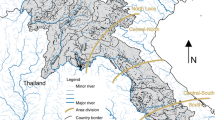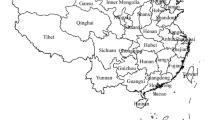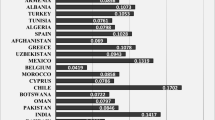Abstract
The Water Poverty Index (WPI) expands the analysis of China’s water crises from hydrology to a broader focus on integrated water resources management including economic and social factors. This index was revised by principal component analysis (PCA) to avoid arbitrariness of weights and collinearity between variables. However, the traditional PCA is primarily oriented for static data, and it fails to reveal the evolutionary trend of data over time. Moreover, the conventional normalization methods are not adequate when the dimension of time is added to the data. In this study, the transformation of centralized logarithm of initial variable and holistic and dynamic principal component analysis are firstly proposed, then the improved methods are applied to assess water poverty in China using panel data from 2004 to 2012. The estimated WPI shows the growing scale and the clustering trend of regional water poverty. The analysis of influential factors reveals that aquatic environmental pollution is a vital driver of water poverty. Water resource endowment is the second important factor concerning regional water poverty. Inability to adapt to water scarcity, which leads to weak physical water access and low efficiency of water use, is still a critical driver of regional water poverty. Finally, the regional disparities and alleviation strategies of water poverty are discussed.





Similar content being viewed by others
References
Cho, I. D., Ogwang, T., & Opio, C. (2010). Simplifying the Water Poverty Index. Social Indicators Research, 97, 257–267.
Dunteman, G. H. (1989). Principal components analysis. Newbury Park, CA: Sage.
Feitelson, E., & Chenoweth, J. (2002). Water poverty: Towards a meaningful indicator. Water Policy, 4, 263–281.
Gine Garriga, R., & Perez Foguet, A. (2010). Improved method to calculate a Water Poverty Index at local scale. Journal of Environmental Engineering, 11, 1287–1300.
Gine Garriga, R., & Perez Foguet, A. (2011). Application of a revised Water Poverty Index to target the water poor. Water Science and Technology, 6, 1099–1112.
Gleick, P. (1996). Basic water requirements for human activities: Meeting basic needs. Water International, 21, 83–92.
Heidecke, C. (2006). Development and evaluation of a regional water poverty index for Benin. EPT Discussion Paper 145, Environment and Production Technology Division, International Food Policy Research Institute, January. http://www.ifpri.org/divs/EPTD/DP/papers/eptdp145.pdf
Jemmali, H., & Matoussi, M. S. (2013). A multidimensional analysis of water poverty at local scale: Application of improved water poverty index for Tunisia. Water Policy, 15, 98–115.
Jemmali, H., & Sullivan, C. (2014). Multidimensional analysis of water poverty in MENA region: An empirical comparison with physical indicators. Social Indicator Research, 115, 253–277.
Jiang, Y. (2009). China’s water scarcity. Journal of Environmental Management, 90, 3185–3196.
Johnson, R. A., & Wichern, D. W. (2007). Applied multivariate statistical analysis [M] (6th ed.). Upper Saddle River: Pearson Education Incorporation, publishing as Prentice Hall.
Jolliffe, I. T. (1986). Principal component analysis. New York: Springer.
Komnenic, V., Ahlers, R., & Zaag, P. (2009). Assessing the usefulness of water poverty index by applying it to a special case: Can one be water poor with high levels of access? Physics and Chemistry of the Earth, 34, 219–224.
Lawrence, P., Meigh, J., Sullivan, C. (2002). The water poverty index: An international comparison. Keele Economics Research Paper, 19. Staffordshire, UK.
Liu, Z., Wang, X., & Chen, X. (2012). The influence of data transformation to extracting principal component. Science Technology and Engineering, 12(6), 1348–1351. (In Chinese).
Molle, F., & Mollinga, P. (2003). Water poverty indicators: Conceptual problems and policy issues. Water Policy, 5(5), 529–544.
Nardo, M., et al. (2005). Handbook on constructing composite indicators: Methodology and user guide. OECD Statistics Working Papers.
Nardo, M., Saisana, M., Saltelli, A., Tarantola, S. (2005). Tools for composite-indicator building. In: Institute for the Protection and Security of the Citizen, European Commission
National Bureau of Statistics, Ministry of Environmental Protection. China Statistical Yearbook on Environment. (2005–2013). China Statistic Press, Beijing, China (in Chinese). http://www.stats.gov.cn/ staticreq.htm
National Bureau of Statistics of China. China Statistical Yearbook. (2005–2013). China Statistic Press, Beijing, China (in Chinese). http://www.stats.gov.cn/ easyquery.htm?cn=E0103
OECD (Organization for Economic Cooperation and Development). (2007). Environmental performance reviews: China. Paris, France: OECD.
Perez Foguet, A., & Gine Garriga, R. (2011). Analyzing water poverty in basins. Water Resources Management, 25(14), 3595–3612.
Qiu, J. (2011). China to spend billions cleaning up groundwater. Science, 334, 745.
Rijsberman, F. R. (2006). Water scarcity: Fact or fiction? Agricultural Water Management, 80(1–3), 5–22.
SC (State Council, P.R. China). (2006). The 11th Five-Year National Plan for Social and Economic Development. Beijing, China: People’s Publishing House.
Sullivan, C. (2002). Calculating a water poverty index. World Development, 30(7), 1195–1210.
Sullivan, C. (2005). Method to develop and describe community level water poverty index scores. UK: CEH Wallingford.
Sullivan, C., Meigh, J., et al. (2003). The Water Poverty Index: Development and application at the community scale. Natural Resources Forum, 27, 189–199.
Sullivan, C., Meigh, J., et al. (2007). Integration of the biophysical and social sciences using an indicator approach: Addressing water problems at different scales. Water Resources Management, 21(1), 111–128.
Todd, H. (2010). China’s water scarcity and its implications for domestic and international stability. Asian Affairs: An American Review, 37, 71–83.
WB (World Bank). (2007). Water pollution emergencies in China. Washington, DC, USA: World Bank.
Ye, S. (2001). The application and consideration about principal component analysis. Data Statistics and Management, 20(2), 52–56. (in Chinese).
Zhang, C., & Chen, S. (1996). The principal component analysis on component data and its applications. Mathematical Statistics and Management, 15(3), 11–15. (in Chinese).
Zhou, O., Ang, B. W., & Poh, K. L. (2006). Comparing aggregation methods for constructing the composite environmental index: An objective measure. Ecological Economics, 59(3), 305–311.
Acknowledgments
This work was supported in part by the Humanities and Social Science Research Fund of Ministry of Education of P.R. China under Grant No. 11YJC840038, and under Grant No. 14YJA840010.
Author information
Authors and Affiliations
Corresponding author
Rights and permissions
About this article
Cite this article
Pan, A., Bosch, D. & Ma, H. Assessing Water Poverty in China Using Holistic and Dynamic Principal Component Analysis. Soc Indic Res 130, 537–561 (2017). https://doi.org/10.1007/s11205-015-1191-3
Accepted:
Published:
Issue Date:
DOI: https://doi.org/10.1007/s11205-015-1191-3




